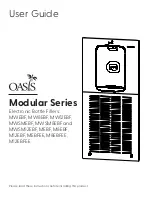
/ indd4
V-VC
202
303
dB(A)
50 Hz
73
73
60 Hz
76
77
kg
50 Hz
174
187
60 Hz
191
192
mm
50 Hz
835
920
60 Hz
920
920
mm
523
523
mm
50 Hz
378
398
60 Hz
407
407
l
8
8
���
k
v
n
q
s
5
m
v
1
3.09
4. Coupling
(picture
���
)
The tooth rim (k) is a wearing part and must be checked regularly (at least once a year), at the same time clean the cooling snake (v
1
) by blowing
out with compressed air.
Caution – defected tooth rim
Defected tooth rim can cause extensive damage and even in some extreme cases break the rotor shaft.
To check the coupling, stop the motor (m) and isolate. Remove the screws (s
5
) on the motor fl ange (n). Pull off the motor together with the motor
side coupling half (q). If the tooth rim (k) is damaged or worn then exchange the rim. The fan (v) should be also checked regularly on demages and
if necessary be exchanged.
Note
Frequent start-up and high ambient temperature
shorten the lifetime of the tooth rim (k).
Re-assemble in reverse order.
Trouble Shooting
1.
Motor starter cuts out vacuum pump:
1.1 Check that the incoming voltage and frequency cor-
responds with the motor data plate.
1.2 Check the connections on the motor terminal block.
1.3 Incorrect setting on the motor starter.
1.4 Motor starter trips too fast.
Solution: Use a motor starter with a time delay trip (ver-
sion as per IEC 947-4).
1.5 The vacuum pump or the lubricating oil is too cold.
1.6 The viscosity of lubricant is too high.
1.7 Oil mist eliminator elements are blocked or contami-
nated.
1.8 Back pressure on the exhaust pipework is excessive.
1.9 Continuous operation > 100 mbar (abs.) Solution: Use
a bigger motor size.
2. Insuffi cient suction capacity:
2.1 Inlet
fi lters or meshes are obscured.
2.2 Suction pipe work is too long or too small.
3.
Vacuum pump does not reach ultimate vacuum:
3.1 Check for leaks on the suction side of the pump or on the system.
3.2 Viscosity of lubricant incorrect.
4.
Vacuum pump operates at an abnormally high temperature:
4.1 Ambient or suction temperature too high.
4.2 Cooling air fl ow is restricted.
4.3 Problem as per 1.6, 1.7 and 1.8.
5.
Exhausted air contains visible oil mist:
5.1 Oil separator elements are fi tted incorrectly.
5.2 Incorrect oil brand is used.
5.3 Problem as per 1.7, 1.8, 4.1 and 4.2.
6.
Unit emits abnormal noise:
Note: A knocking noise from the rotor blades is normal when starting from cold, as long as it disappears within two minutes with increasing
operating temperature.
6.1 The pump cylinder is worn.
Solution: send your complete unit off for repair to the supplier or approved service agent.
6.2 The vacuum regulating valve is noisy. Solution: replace valve.
6.3 Blades are damaged.
6.4 Problem as per 1.5 and 1.6.
7.
Water in lubricant i.e. Emulsifi cation:
7.1 Pump pulls in water because of the application. Solution: Fit water separators on to the vacuum side.
7.2 Unit handles more water vapour than the gas ballast is designed for.
Solution: Consult supplier for the provision of an increased gas ballast capability.
7.3 Pump operates only for a short time and does not reach normal operating temperature.
Solution: Run the pump with closed suction until the oil has been cleaned.
Appendix:
Repair on Site: For all repairs on site an electrician must disconnect the motor so that an accidental start of the unit cannot happen.
All engineers are recommended to consult the original manufacturer or one of the subsidiaries, agents or service agents. The address of the near-
est repair workshop can be obtained from the manufacturer on application.
After a repair or before re-installation, follow the instructions as
shown under the headings ”Installation and Initial Operation”.
Lifting and Transport: To lift and transport the vacuum pump the
eye bolts on the pump and motor must be used. If an eye bolt
is missing use suitably rated strops. The weight of the pumps is
shown in the accompanying table.
Storage: V-VC units must be stored in dry ambient conditions with
normal humidity. If a pump needs to be stocked for a period longer
than 3 months we would recommend using an anticorrosion oil
rather than the normal lubricant.
Disposal: The wearing parts (as listed in the spare parts lists)
should be disposed of with due regard to health and safety
regulations.
Spare parts lists:
E 232/20
➝
V-VC 202 - V-VC 303
Noise level (max.)
Weight (max.)
Length
Width
Height
Oil capacity


































